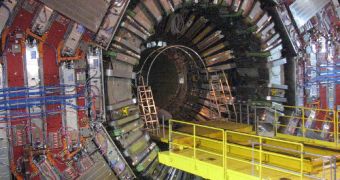Officials at the European Organization for Nuclear Research (CERN) announce that the most powerful particle accelerator in the world, the Large Hadron Collider (LHC), will be brought back online next week. The largest physics experiment in the world was shut down for a few weeks during the holidays, and it is now able to resume its scientific measurements. As the machine restarts, it will not climb to its maximum energy levels, but will rather continue at lower energies throughout this year, the BBC News reports. The LHC was first started late last year.
Following a glitch in its cooling system, the massive particle accelerator suffered a catastrophic liquid helium leak in autumn 2008, when it was originally scheduled to come online. The opening was delayed by more than a year, but its tunnels eventually started being used for accelerating streams of protons in September 2009. Since then, physicists have slowly increased the energy of each of the two beams running through the 27-kilometer-long ring, until the combined energy output exceeded all others in the world. In December, the LHC officially became the most powerful particle collider in the world, when it exceeded Fermilab's Tevatron facility by a slight margin.
Now, following a small hiatus caused by the holiday season, the international project is scheduled to resume operations beginning with the week of February 22. Though it's capable of developing tremendous energies on each of the beams, the accelerator will be operated at a lower level, known as the “injection energy.” The energy levels will be increased in small increments, until they reach 2009's record of 2.36 TeV (teraelectronvolts) in total. They will then be further increased, until they reach this year's stated goal, of 7 TeV in total, or 3.5 TeV per beam.
“We went into a technical shutdown over Christmas and we're now ready to switch it back on again,” a CERN spokesperson told the British news agency. He added that the firm opening date had yet to be set, but that the following week would most definitely see the LHC springing back to life. Collisions here have already produced a scientific paper, which shows that the debris field caused by colliding protons is a lot larger than all theoretical models predicted. Physicists are on the edge of their seats, waiting to see the machine operating at full capacity. However, the maximum energy output of 14 Tev (7 TeV per beam), will only be achieved sometime in 2013.

 14 DAY TRIAL //
14 DAY TRIAL //